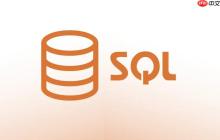-

- AI执行SQL数组操作怎么做_利用AI处理数组数据类型教程
- AI通过理解与生成能力辅助处理SQL数组数据,首先解析非结构化数组内容,继而生成复杂SQL语句如UNNEST或JSON_EXTRACT操作,并在数据提取后进行深度分析,解决传统模型难处理嵌套数据的问题。
- SQL . 数据库 419 2025-09-17 21:19:01
-

- MySQL插入外键关联数据怎么办_MySQL外键数据插入注意事项
- 答案:插入外键数据需先确保父表存在对应主键。应遵循先父后子的顺序,检查数据类型一致性和外键约束,合理处理NULL值,并利用事务保证数据一致性,批量插入时可采用多行INSERT提升效率,必要时谨慎禁用外键检查,同时理解ONDELETE/UPDATE行为对数据生命周期的影响。
- SQL . 数据库 951 2025-09-17 21:13:01
-

- 大量并发查询如何优化_高并发场景下的数据库调优
- 答案是通过索引优化、缓存策略、读写分离、分库分表等多维度手段系统性降低数据库压力。具体包括:基于查询模式设计复合索引并遵循最左匹配原则,利用覆盖索引减少回表;采用Redis等分布式缓存结合Cache-Aside模式减轻数据库负载,并通过TTL和主动失效保障一致性;实施读写分离以分散读请求压力,同时合理配置连接池参数提升资源利用率;在数据量级达到瓶颈时引入分片架构,结合异步队列与NoSQL技术实现系统整体可扩展性。
- SQL . 数据库 1010 2025-09-17 21:09:01
-

- 网页如何实现数据监控SQL_网页实现SQL数据监控的教程
- 答案是建立SQL监控系统需选合适工具、配告警规则、做数据可视化并避免性能损耗。首先根据需求选择开源(如Prometheus+Grafana)或商业工具(如Datadog),明确监控指标与频率;接着配置合理阈值告警,区分紧急程度采用短信、邮件等通知方式;通过Grafana等工具创建仪表盘实现CPU、内存、慢查询等指标的可视化分析;为减少性能影响,应降低采集频率、聚焦关键指标、使用轻量工具;最后利用监控数据定位瓶颈,优化SQL语句、存储结构或硬件,持续提升数据库性能。
- SQL . 数据库 234 2025-09-17 20:30:04
-

- 数据库内存如何优化配置_内存参数调整与性能提升
- 答案:数据库内存优化需合理分配内存资源以提升性能和稳定性,核心是理解数据库内存使用机制及业务负载模式。首先建立系统内存使用基线,监控操作系统与数据库内部状态,重点关注数据缓存、索引缓存、连接会话内存、排序及临时操作内存等关键区域。调整参数时应逐项进行,避免频繁Swap和IO瓶颈。不同数据库关注参数不同:MySQL重点为innodb_buffer_pool_size、tmp_table_size等;PostgreSQL关注shared_buffers、work_mem等;Oracle则需配置SGA
- SQL . 数据库 649 2025-09-17 20:16:01
-

- SQLite只读数据源怎么创建_SQLite只读数据源设置方法
- 设置SQLite为只读数据源有两种主要方式:一是通过文件系统权限控制,如Linux/macOS使用chmod444或Windows修改文件安全属性,彻底禁止写入,适用于严格只读场景;二是应用程序连接时指定只读模式,如使用URI参数mode=ro,在Python、C#、Java等语言中通过连接字符串实现,灵活性高但仅限当前连接有效。前者操作系统级防护更安全,后者适合同一应用内不同模块按需访问。选择依据实际需求:若需防止任何写入,推荐文件权限;若仅需限制特定连接,则用mode=ro。常见应用场景包括
- SQL . 数据库 490 2025-09-17 20:05:01
-

- SQL连续登录解法怎么避免性能问题_SQL避免全表扫描技巧
- 优化SQL连续登录性能需从索引设计、数据范围限制和查询方式三方面入手,首先创建user_id和login_time的组合索引以避免全表扫描,其次通过时间与用户范围过滤减少数据量,再结合EXISTS替代COUNT、避免WHERE中使用函数、合理使用UNIONALL与分页等技巧提升效率,最后利用EXPLAIN分析执行计划并定期维护索引,确保查询高效稳定。
- SQL . 数据库 219 2025-09-17 19:43:01
-

- SQLMIN函数怎么找最小值_SQLMIN函数查找最小值教程
- MIN函数用于查找一列中的最小值,可与WHERE子句结合筛选特定条件下的最小值,如SELECTMIN(price)FROMproductsWHEREcategory='电子产品';它会忽略NULL值,仅在非NULL值中找最小值;结合GROUPBY可分组求最小值,再用HAVING过滤分组结果,如HAVINGMIN(total_amount)
- SQL . 数据库 768 2025-09-17 19:30:02
-

- SQL触发器性能如何优化_触发器设计与性能优化指南
- 选择合适的触发器类型并优化逻辑与索引是提升SQL触发器性能的关键。FOR触发器适用于数据修改后的辅助操作,如审计日志;INSTEADOF触发器适合需完全控制修改过程的场景,如视图更新,可减少冗余操作。应避免在触发器中执行长事务和复杂逻辑,尽量减少操作、使用批量处理,并将耗时任务(如发邮件)移至异步队列。确保触发器内SQL语句高效,利用索引加速查询,尤其在WHERE条件列上建索引,但需权衡索引数量以避免写入开销。通过性能分析工具、执行计划、扩展事件和日志监控触发器行为,及时发现瓶颈并优化,从而保障
- SQL . 数据库 894 2025-09-17 19:06:02
-

- AI如何执行多表关联查询SQL_利用AI运行复杂关联查询步骤
- AI在复杂SQL关联查询中扮演智能“翻译官”和“架构师”角色,通过理解自然语言需求、解析数据模型与关联关系,生成并优化多表JOIN语句。它首先基于数据库Schema和元数据识别表间关系,再利用NLP解析用户意图,确定涉及的实体(如客户、订单)、属性(如时间、销售额)及操作(如汇总、过滤),进而构建逻辑查询计划,选择合适的JOIN类型与路径,并翻译为具体SQL。AI还能推荐优化策略,如索引使用或JOIN顺序调整,降低非专业人员使用门槛。然而,AI生成的SQL仍需人工审查,以确保逻辑准确性、性能高效
- SQL . 数据库 723 2025-09-17 18:51:01
-

- 数据库备份期间如何优化查询_备份时查询性能保持方法
- 答案:通过选择在线备份、优化查询、资源隔离及监控调整等策略,可在保障数据安全的同时减少备份对查询性能的影响。
- SQL . 数据库 613 2025-09-17 18:49:01
-

- SQL语句索引失效怎么办_避免索引失效及索引优化技巧
- 索引失效主因包括数据类型不匹配、索引列使用函数或计算、否定操作符、OR条件未优化、LIKE以%开头、组合索引未遵循最左前缀及统计信息不准,解决需确保类型一致、避免列上函数、优化查询结构、使用覆盖索引并定期更新统计信息。
- SQL . 数据库 623 2025-09-17 18:39:01
-

- 查询结果集过大如何优化_减少网络传输的结果集分页策略
- 最核心的优化策略是实施分页,通过LIMIT和OFFSET实现简单但深分页性能差,应优先采用基于游标(如WHEREid>last_id)的分页方式以避免扫描跳过大量数据,结合索引优化、减少SELECT*、使用缓存及混合策略来提升性能。
- SQL . 数据库 523 2025-09-17 18:38:01
-

- 数据库连接池如何优化_连接池配置与性能调优方法
- 优化数据库连接池需选择合适实现并精细配置参数。1.优先选用HikariCP或Druid,前者性能优异,后者监控功能强大;2.合理设置maximumPoolSize避免过高导致数据库压力过大或过低引发连接耗尽;3.配置minimumIdle保持适量空闲连接以应对突发流量;4.设置合理的connectionTimeout防止请求长时间阻塞;5.启用leakDetectionThreshold及时发现连接泄露;6.使用validationQuery确保连接有效性;7.开启PreparedStateme
- SQL . 数据库 958 2025-09-17 18:28:01
-

- Oracle插入时压缩数据怎么办_Oracle数据压缩插入技术
- 答案:Oracle通过表压缩技术在插入时压缩数据,主要方式包括OLTP压缩和混合列式压缩(HCC)。OLTP压缩适用于频繁DML操作的场景,对性能影响小;HCC适用于数据仓库,需直接路径插入,压缩率高但依赖特定硬件。现有表可通过ALTERTABLEMOVE启用压缩,但会锁定表;轻量级方法ALTERTABLECOMPRESS仅对新数据生效。不同压缩类型需根据访问模式、硬件和性能需求选择。
- SQL . 数据库 990 2025-09-17 18:27:01

PHP讨论组
组员:3305人话题:1500
PHP一种被广泛应用的开放源代码的多用途脚本语言,和其他技术相比,php本身开源免费; 可以将程序嵌入于HTML中去执行, 执行效率比完全生成htmL标记的CGI要高许多,它运行在服务器端,消耗的系统资源相当少,具有跨平台强、效率高的特性,而且php支持几乎所有流行的数据库以及操作系统,最重要的是





























